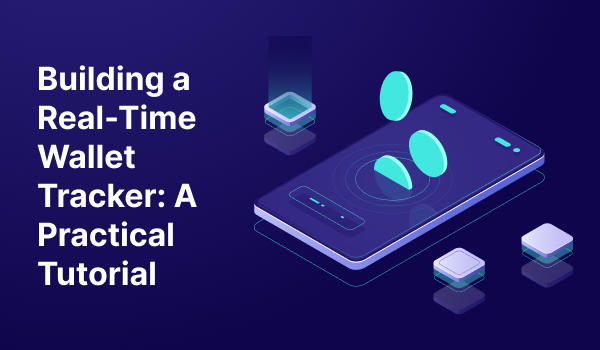How to Build a Real-Time Wallet Tracker
 Mohd Arslan Siddiqui
Mohd Arslan Siddiqui
Before diving into the technical details, let’s explore the benefits of a real-time wallet tracker: Before diving into the technical details, let’s explore the benefits of a real-time wallet tracker, under the crypto wallet development part:
1. Instant Updates: You have the ability to check your spending and financial health instantly and on the go.
2. Better Budgeting: Real-time expenditure monitoring can easily be done against the spending plan.
3. Fraud Detection: Originate methods to identify such transactions, and act accordingly instantly.
4. Convenience: Have full account access to your financial information from the palm of your hand via your Android phone, iPhone, tablet, or PC.
Getting Started: Planning Your Wallet Tracker
Define Your Goals
When using your wallet tracker, what is its purpose, or what do you wish to accomplish? Common features include:
- Transaction tracking
- Balance updates
- Budget management
- Low balance warnings or notification of suspicious activity
Choose Your Technology Stack
Here’s a suggested tech stack:
- Frontend: React. js or Vue. js to designing an interface that can react to changes in size and shape.
- Backend: Node. js with Express. This function is used for the handling of API requests using js.
- Database: MongoDB to handle data related to customers and transactions.
- Real-Time Updates: Socket. io for continuous communication between the frontend and the backend usually through the use of messages.
Design Your Data Model
In this worksheet, the data structure or schema you will have to define is not defined clearly. For a wallet tracker, you’ll need at least:For a wallet tracker, you’ll need at least:
- Users: Subscribing details, User credentials
- Accounts: One has to differentiate between a wallet or bank account of the victim or a non-victim.
- Transactions: Specific information about each transaction, especially the monetary value, the date when the transaction took place, and where the transaction occurred when it is “¦
- Budgets: User-defined budgets for different categories Whether for business or personal use, it is common that individuals need to create a budget plan for different categories.
Building the Real-Time Wallet Tracker
Step 1: Setting Up the Backend
1. Initialize the Node.js Project
sudo
mkdir wallet-tracker
cd wallet-tracker
npm init -y
2. Install Dependencies
npm install express mongoose socket.io body-parser
3. Create the Server
const express = require('express');
const mongoose = require('mongoose');
const http = require('http');
const socketIo = require('socket.io');
const bodyParser = require('body-parser');
const app = express();
const server = http.createServer(app);
const io = socketIo(server);
mongoose.connect('mongodb://localhost:8080/walletTracker', { useNewUrlParser: true, useUnifiedTopology: true });
app.use(bodyParser.json());
// Define your schemas and routes here
server.listen(3000, () => {
console.log('Server is running on port 3000');
});
io.on('connection', (socket) => {
console.log('New client connected');
socket.on('disconnect', () => {
console.log('Client disconnected');
});
});
Step 2: Setting Up the Database Models
Create models for Users, Accounts, Transactions, and Budgets.
const mongoose = require('mongoose');
const userSchema = new mongoose.Schema({
username: String,
password: String,
email: String,
});
const accountSchema = new mongoose.Schema({
userId: mongoose.Schema.Types.ObjectId,
name: String,
balance: Number,
});
const transactionSchema = new mongoose.Schema({
accountId: mongoose.Schema.Types.ObjectId,
amount: Number,
date: Date,
category: String,
description: String,
});
const budgetSchema = new mongoose.Schema({
userId: mongoose.Schema.Types.ObjectId,
category: String,
limit: Number,
spent: Number,
});
const User = mongoose.model('User', userSchema);
const Account = mongoose.model('Account', accountSchema);
const Transaction = mongoose.model('Transaction', transactionSchema);
const Budget = mongoose.model('Budget', budgetSchema);
module.exports = { User, Account, Transaction, Budget };
Step 3: Implementing Real-Time Updates
Integrate Socket.io for real-time updates.
io.on('connection', (socket) => {
console.log('New client connected');
socket.on('newTransaction', async (data) => {
const transaction = new Transaction(data);
await transaction.save();
const account = await Account.findById(data.accountId);
account.balance += data.amount;
await account.save();
io.emit('updateBalance', { accountId: data.accountId, newBalance: account.balance });
});
socket.on('disconnect', () => {
console.log('Client disconnected');
});
});
Step 4: Building the Frontend
1. Create a React App
npx create-react-app wallet-tracker-frontend
cd wallet-tracker-frontend
2. Install Socket.io Client
npm install socket.io-client
3. Connect to the Backend
import React, { useEffect, useState } from 'react';
import socketIOClient from 'socket.io-client';
const ENDPOINT = "http://localhost:3000";
const socket = socketIOClient(ENDPOINT);
function WalletTracker() {
const [balance, setBalance] = useState(0);
useEffect(() => {
socket.on('updateBalance', (data) => {
if (data.accountId === YOUR_ACCOUNT_ID) {
setBalance(data.newBalance);
}
});
return () => socket.disconnect();
}, []);
return (
<div>
<h1>Wallet Tracker</h1>
<p>Current Balance: ${balance}</p>
</div>
);
}
export default WalletTracker;
Step 5: Testing and Deployment
1. Test Your Application
When developing a website, ensure that each implemented feature is working as provided and debug any issues that may be noted.
2. Deploy Your Application
The backend should be deployed by using services such as Heroku while the frontend deploys by the usage of Netlify.
Conclusion
In order to make a wallet tracker, one needs to ensure that there is a server side to handle data and update the database in real-time or near real-time to provide the updated data to the client side, which will be refreshed in near real-time to display the data to the users. When done following the guidelines in this guide, one can develop a tool that efficiently manages personal finances. A real-time wallet tracker, simple for use or complex as a sample of your coding abilities, is a very functional tool for a wide variety of purposes. Contact our blockchain developers for expert services in crypto wallet development.
Subscribe to my newsletter
Read articles from Mohd Arslan Siddiqui directly inside your inbox. Subscribe to the newsletter, and don't miss out.
Written by

Mohd Arslan Siddiqui
Mohd Arslan Siddiqui
Expert blockchain writer with a knack for simplicity. Blends technical depth with engaging storytelling.